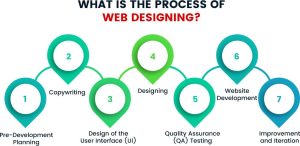Hey folks,
Are you interested in learning what is Web Design and all the steps required for how to design a website?
If yes, let’s get the ball rolling without wasting much time!!!
This ultimate guide to designing a website will surely enrich you with the right inputs to help you with the basic steps to design a website for a great outcome.
What is Web Design?
Web Design as the name suggests is the layout or design of a website that is displayed on the internet. It is basically the process of planning, conceptualizing, designing and developing a website that represents the face of an organization for connecting with the target audience.

So, you must be thinking, what is responsive web design?
Well, today, website design extends beyond aesthetics to incorporate the overall operations of the website. Web design also encompasses the creation of web apps, mobile apps, and user interfaces for reaching a wider audience and that’s what we call a responsive web design that is compatible and responsive on all interfaces.
Web design encompasses numerous aspects that are integral for creating webpage designs and include components like:
Layout and Design
The most important component of a website is its layout and design. This includes the fonts, colors, and layout designs for each page of your website.
Content
Content is an integral part of web designing, without which a website will have no existence. Thus, it is the basic steps to design a website and include content in the form of blogs, articles, videos, and images that are the key elements of a website to make it successful.
Graphics and Pictures
Graphics and pictures provide visual appeal to a website that helps in attracting audiences. Therefore, it is very important to incorporate them effectively while designing a website. Make sure to choose visuals that symbolize your brand and appeal to your target demographics.
Web Hosting and Domain Name
You will need a web host to make your website accessible online to users. Also, a domain name is pretty much required to give it a unique identity and name for the users to identify it easily.
Search Engine Optimization(SEO)
SEO is highly significant for every business, but it is especially critical for websites that cater to online clients. While creating web page designs, Titles, title tags, meta descriptions, and other text components on your site should be given utmost importance. Always make sure to incorporate the appropriate keywords and phrases into them from an SEO perspective to be easily identifiable by Google.
What is the Process of Web Designing?
There is no set rule and approach for how to create a web page design, although the basic steps to create a web page design often comprises the following steps:
Pre-Development Planning
The very first step involved in the process regarding what is web designing involves pre-development strategy planning to chalk out all the possibilities to smoothen the process.
During pre-development, the designer will investigate the project concept and collect all relevant information, such as the target audience, business goals, and the first vision. This stage also aids in determining which technologies must be employed and how they will be incorporated into the final product.
Copywriting
Next, the process for how to create a web page design includes creating valuable and relevant content for your website and optimizing it for SEO.
Following early research and development, the designer begins writing the website’s content. This includes creating intriguing descriptions that will entice potential buyers, as well as producing excellent SEO content that will help your site rank higher in search engines.
Designing
The design process begins once pre-development is complete. During this stage, the web designer sketches and visualizes the finished product, irons out any wrinkles in the layout and UI/UX design, and sets a uniform style for all parts of the site. Creating wireframes to encourage feedback from stakeholders is part of this process.
Design of the User Interface (UI)
When the design is complete, the web designer starts working on the user interface (UI). This includes creating all of the pages and components needed for a good online experience, such as major menus, pop-ups, and adverts. It also entails generating pixel-perfect logos, favicons, and other visuals for usage across the site.
If you haven’t yet decided on a logo for your business, you can design one on your own. For this, refer to “How To Create a Pro Logo Design” and get yourself a detailed and personalized logo today.
Website Development
After the designs have been approved (and any required alterations have been done), development may commence, which can involve coding, testing, and tweaks. Finally, the goal is to create a finished product that satisfies all project objectives while exceeding customer expectations.
Quality Assurance (QA) Testing
When development is finished, the quality assurance (QA) team takes over. This includes completing final tests to ensure that all text, images, and code are error-free before release. Additionally, any necessary changes or repairs may be done before publishing.
Improvement and Iteration
After the site is live, constant iterations are required to keep it updated and new — a never-ending work for any web design team. And, as always, more tuning may be done as needed based on input from users/clients.
Also Read, Tips to Make Money as a Web Designer
6 Tips for An Amazing Web Design
After learning about what is web design, let’s understand how to create web page design.
Here is an ultimate guide to help professionals, designers, or creators to design a good web design for their website that leaves a lasting impression on the user.
1. Choosing The Right Web Design Tool
The first step in how to create a web design involves choosing the right web design tool. Based on the size of the team, time, budget, and type of site you can experiment with two ways namely a desktop app or website builder.
Designers can create designs on platforms like Photoshop and later send them to the development team who can convert the design into code. This method is beneficial for large and complex companies where the task of designing is laid in expert hands and supervision but is a bit time-consuming and requires technology, a team of people, and is expensive.
On the other hand, there are a lot of website builders offering myriad features and services like Wix, WordPress, and many more determined on the style of templates, price, design styles, and editing pattern that serves as an excellent helping tool for designing extraordinary websites.
While making a decision on the tool you need to decide on what kind of a website are you making, how often will you edit it what all information will your webpage consist of, all these will give you a clear and better picture to work on the rest details.
You can also try Free Website Design Software For Beginners if you are unhandy with programming. These CMS platforms are easy to design and manage.
2. Interactive Design
The steps taken to design a website include having an interactive design. Web designers need to look for how can they optimize and build their digital experiences to make them user-friendly. And to perform this task a specific set of skills and knowledge is a prerequisite and they should be specialized in specific web design fields even a mobile app or website creation.
It does not just have to do away with the software development part but it has to do with the user’s experience of the web design. This is how the user is going to perceive the web design after visiting it and how appealing it looks to them.
It is related to how clear the labels are how attractive is the layout and how relevant is the information provided on it. If the website is less user-friendly they might no longer continue to use it.
3. Marketing Design
This is how we communicate via the website with our users so the designer needs to understand the trend of the user preference. The Web design is also based on the type of website like B2C, B2B, retail, informative, and entertainment. So an effort has to be made to put a favorable image of the brand in the eyes of users.
The web design world is as dynamic as the digital world today where things and new trends need to stay updated on your website to make it look young forever by optimizing its performance and functional outcome. Web design even has to do with how your website looks, feels, and works on various devices to strengthen your digital presence and turn your venture successful by creating the right product at right time.\
Have a look at “Must-have Chrome Extensions for Web Developers” and improve your productivity in web designing.
4. Physical Elements Of Web Design
Physical elements of a web design help in providing an attractive appearance of a website. It also includes technical functionality to determine the site’s usability and performance. Web design usability includes elements like an easy-to-navigate interface, appropriate usage of graphics and images, well-written and placed text, and color and site performance refers to its searchability, speed, ranking, and ability to grab the attention of the audience.
So content that will fit in with the images and graphics of the website must be pre-planned, the correct font to enhance the look of the entire website must be carefully opted for, colors and psychology of colors must not be misunderstood so colors that overall fit the tone of your website must be chosen.
The use of good layouts and shapes will let the users have an add-on attraction to the website. Spacing between the texts and images and also the spacing between one set of information and another needs to be taken care of to make the website look precise and simpler.
5. Functional Elements Of Web Design
This is important as it determines how the website works and this will ultimately make your website rank on search engines so the user needs to get the best possible experience. Like the user must not feel they are in no control of the website by getting regular pop-ups auto-playing audio, videos, or too many interactive boxes. The navigation related to using the website and its user experience must be simple and clear.
The structure of the website must not complicate the user to find the page of their choice or come back to the one they read earlier and so must the animations. Finally, the site must respond in a few seconds as users are not very inclined towards waiting for slow websites to load, because if loading takes time the site won’t be searched more on the internet.
6. Compatibility
The web design must be compatible with all the browsers on all the devices with images and videos not getting distorted and the design being laid in an attractive fashion with information and agenda being served properly. A compatibility test is a must in today’s world as people are more likely to surf from whichever device is available to them on the go.
It is always advisable to hire a professional web development agency to design an outstanding website for your business to reach out to your target customers effectively.
Softhunters is the leading and the best website development company in Jaipur with experience of over 12 years known for offering exceptional services in web designing. In case you are in need of professional assistance you can always reach out to us.
You might also like, How To Choose A Web Design Company? [Guide]
Tips To Enhance the look of a Website
Web designers look for inspiration to design their websites. A disoriented or outdated website will make your brand look bad so in order to save that image from getting ruined at the first glance, it is important to put in creative efforts for the look and feel of your website. Web design is all about how you place the images or content over the website to make it look and stay forever in the minds of your audience.
With a proper mix of aesthetic and functional elements, web design is what makes the look of a website like its fonts, colors, and graphics as well as designing the site’s structure and deriving a good users experience out of it.
Web design must be responsive and the arrangement of the content and images must be relevant and be placed with a balance of the amount of content and images on a webpage. Web designers are expected to be aware of usability and also create markup, if their role is to do that, then they are also expected to be up to date with website accessibility guidelines.
So a designer basically works on the appearance which is the color, font or style, and layout as to how the information has been placed and categorized with proper content on the website. A web design should be aesthetic and simple with no overdo of information that bores the user so all those points that can create a sense of frustration are to be avoided by the designer.
Things To Be Avoided While Designing A Website
- Non-responsiveness of the website.
- Too many compressed animations.
- Distracting background images or layout.
- Generic or unrequited images.
- Too many pop-ups.
After going through the basics of web design we see that a relationship to start with your target audience starts with web design which should be great and very welcoming. So it is very important to have a good web presence for not to let your brand suffer a hold-back due to it.
Wrapping Up
What is a web design and how to create a web page design are the important questions that every online business is looking for to expand their business through their website. But it is a very technical process and involves a lot of planning.
The steps to design a website include various crucial components that are integral in making it useful. Thus, designing a website involves a lot of planning, designing, and implementing processes to make it a successful one.







